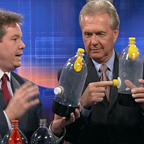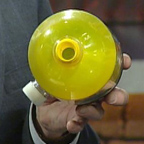Starting Small: A Quarter Through a Dime-Sized Hole
- Fold an index card in half, widthwise.
- Unfold the card and trace a dime so that it is centered on the card. Use the crease as a guideline.
- Refold the card and cut out the shape of the traced dime.
- Now that you have a dime-sized hole, try to fit a quarter through it. It's just not possible, right?
- Here's the trick . . . . With the card folded along the crease, place the quarter inside of the folded card. Make sure that the quarter is centered on the dime-sized hole you already cut.
- Grip each of the corners on the folded end of the card with your thumb and index finger. Pull the corners up and watch as the quarter slides out the dime-sized hole.
- Fold an index card in half, lengthwise this time.
- Unfold the card and cut an incision along the crease that you've created. Don't cut all the way to the either end of the card. Leave 1/8" to 1/4" on each end.
- Fold the card in half again along the same crease as before.
- Carefully make a cut at the point your first incision stopped at a 90º angle down towards the open or unfolded side of the card. Again, remember to leave a 1/8" to 1/4" gap.
- Repeat the previous step, this time starting from the open side of the card, leaving a gap before you get to the other incision.
- Continue making alternating cuts along the length of the card until you reach the other side.
- Gently pull the card open by pulling on the two ends of your original crease. The resulting, zig-zagging loop will be big enough to fit over your entire body!
How does it work?
Both of these Index Card Tricks are based on topology. Topology is concerned with continuous deformation of objects and how the way a surface or object is analyzed and manipulated determines how we understand it. Sounds complicated, right? The science of topology shows how you can alter the shape of an object without altering its size.
In the Quarter Through a Dime-Sized Hole experiment, you are able to change the perceived size of the hole without actually altering it. The squeezing and bunching of different areas of the card allow the hole to gain size along the width of the quarter.
In the Fitting Through an Index Card experiment, when you cut the card as the instructions direct you to, you do not remove any part of the card. You simply change the perceived layout in the zig-zagging loop that allows you to fit through it. In both experiments, topology allows you to change the shape or layout, but not the actual size.
SOURCE: Steve Spangler Science
In the Fitting Through an Index Card experiment, when you cut the card as the instructions direct you to, you do not remove any part of the card. You simply change the perceived layout in the zig-zagging loop that allows you to fit through it. In both experiments, topology allows you to change the shape or layout, but not the actual size.
SOURCE: Steve Spangler Science














































 The balloon won't inflate much the first time because the bottle is already filled with air. There's no room for the balloon to expand inside the bottle. However, when you punch a hole in the bottle, the air molecules in the bottle have an exit. They're pushed out as the balloon fills the space inside. As long as you plug the hole, the balloon stays inflated.
The balloon won't inflate much the first time because the bottle is already filled with air. There's no room for the balloon to expand inside the bottle. However, when you punch a hole in the bottle, the air molecules in the bottle have an exit. They're pushed out as the balloon fills the space inside. As long as you plug the hole, the balloon stays inflated. Try this! Inflate the balloon in the bottle again and cover the nail hole with your thumb. Pour water into the balloon while keeping your thumb over the hole. Go outside or hold the bottle over a sink before you remove your thumb. Watch out for that stream of water gushing out of the bottle top! You might decide to hand a full water-balloon-bottle to a friend and just "forget" to tell them about the hole.
Try this! Inflate the balloon in the bottle again and cover the nail hole with your thumb. Pour water into the balloon while keeping your thumb over the hole. Go outside or hold the bottle over a sink before you remove your thumb. Watch out for that stream of water gushing out of the bottle top! You might decide to hand a full water-balloon-bottle to a friend and just "forget" to tell them about the hole.



